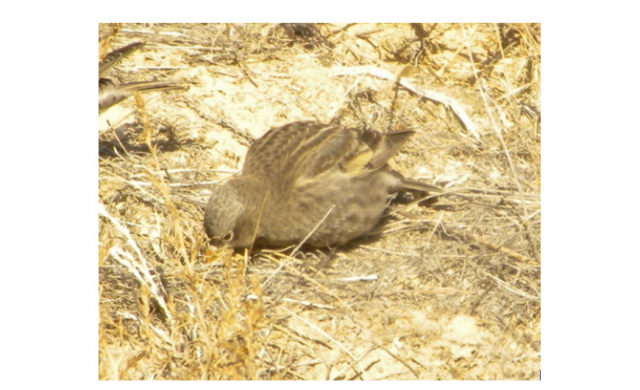Leocosticte atrata
Status: Rare casual winter visitor Panhandle.
Documentation: Photograph: 15 Jan 2001 Wind Springs Ranch, Sioux Co (Hughson; Brogie 2009).
Taxonomy: No subspecies are recognized (AviList 2025).
Hybridization with Gray-crowned Rosy-Finch occurs; Nebraska records of this hybrid are discussed here.
Winter: There are five records:
12 Nov 2000-9 Mar 2001 up to six Sioux Co (Jorgensen 2002, 2003).
5 Jan and 2 Feb 2013 Scottsbluff NM, Scotts Bluff Co (Brogie 2014).
19 Jan 2015 Scotts Bluff NM, Scotts Bluff Co (Brogie 2016)
10 Feb 2001 Agate Fossil Beds SHP, Sioux Co (Jorgensen 2003)
1 Mar 2019 Henry Road, Sioux Co (Willison photo; Brogie 2020).
The first record was of several sightings of up to six birds with a flock of as many as 300+ Gray-crowned Rosy-Finches wintering 2000-2001 at Wind Springs Ranch, Sioux Co (Helen K. Hughson, Stephen J. Dinsmore, personal communication). A single male was found with 216 Gray-crowned Rosy-Finches 12 Nov 2000 (Jorgensen 2002); one of these was photographed 15 Jan 2001 (cited above; Brogie 2009), and on 21 Jan 2001 at least six were with this flock (Jorgensen 2003).
The second record was of a single found 10 Feb 2001 with a flock of about 120 Gray-crowned Rosy-Finches wintering at Agate Fossil Beds SHP (Jorgensen 2003).
The third record was of up to four associating with about 90 Gray-crowned Rosy-Finches at Scottsbluff NM, Scotts Bluff Co, 5 Jan and 2 Feb 2013 (Brogie 2014). The fourth record was at the same location, where one was photographed (Brogie 2016).
The Henry Road site for the fifth record consists of a cliff roosting site along the west side of the road, but actually in Wyoming, and so a Nebraska sighting requires watching the flock fly into Nebraska; one photographed on the cliff there 2 Feb 2019 was deemed to be in Wyoming, but the birds were seen circling around and into Nebraska (Brogie 2020).
This species breeds on certain high-elevation mountain ranges from Idaho and west-central Montana southward through southeast Oregon, northern and eastern Nevada to southern Utah and west and north-central Wyoming, and winters within the breeding range, with a portion of the population regularly wintering up to 125 miles east and 275 miles south of the breeding range (Johnson 2020). It occurs in winter on the eastern Wyoming plains but is rare as far east as the Nebraska border (Faulkner 2010).
Images
Abbreviations
NM: National Monument
SHP: State Historical Park
Literature Cited
AviList Core Team, 2025. AviList: The Global Avian Checklist, v2025. https://doi.org/10.2173/avilist.v2025.
Brogie, M.A. 2009. 2008 (20th) Report of the NOU Records Committee. NBR 77: 80-90.
Brogie, M.A. 2014. 2013 (25th) Report of the NOU Records Committee. NBR 82: 131-146.
Brogie, M.A. 2016. 2015 (27th) Report of the NOU Records Committee. NBR 84: 138-150.
Brogie, M.A. 2020. 2019 (31st) Report of the NOU Records Committee. NBR 88: 124-134.
Faulkner, D.W. 2010. Birds of Wyoming. Roberts and Company, Greenwood Village, Colorado, USA.
Johnson, R.E. 2020. Black Rosy-Finch (Leucosticte atrata), version 1.0. In Birds of the World (A. F. Poole and F. B. Gill, Editors). Cornell Lab of Ornithology, Ithaca, NY, USA. https://doi.org/10.2173/bow.bkrfin.01.
Jorgensen, J.G. 2002. 2002 (sic; =2000). (12th) Report of the NOU Records Committee. NBR 70: 84-90.
Jorgensen, J.G. 2003. 2001 (13th) Report of the NOU Records Committee. NBR 71: 97-102.
Recommended Citation
Silcock, W.R., and J.G. Jorgensen. 2025. Black Rosy-Finch (Leocosticte atrata). In Birds of Nebraska — Online. www.BirdsofNebraska.org
Birds of Nebraska – Online
Updated 21 Jul 2025

